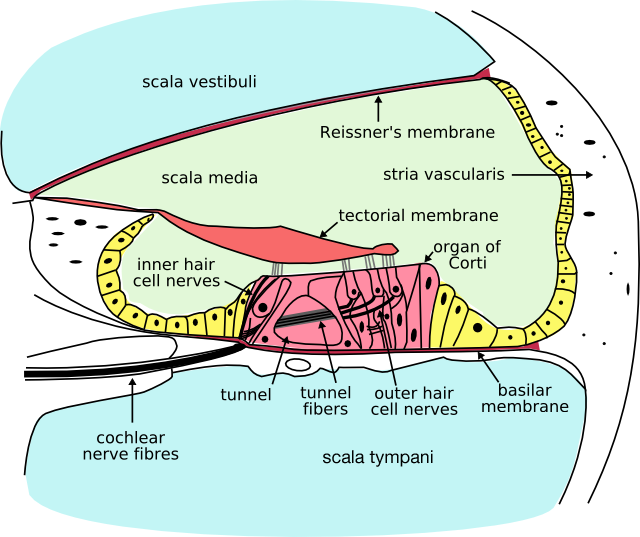Blog
-

“THE BASICS OF HEARING AND HEARING LOSS” (POST 2 of 5)
 10 Dec , 2015
10 Dec , 2015
“THE BASICS OF HEARING AND HEARING LOSS”
(POST 2 of 5)Today’s post will discuss in detail the first of the four known types of hearing loss.
“SENSORINEURAL HEARING LOSS“
Sensorineural hearing loss also known as (SNHL) is a type of hearing loss or deafness, in which the root cause lies in the inner ear (cochlea and associated structures), vestibulocochlear nerve (cranial nerve VIII), or central auditory processing centers of the brain. SNHL accounts for about 90% of all reported hearing loss. A hallmark of such hearing loss is that it is asymmetrically distributed, usually toward the high frequency region, or may have a notch at some frequency. SNHL is generally permanent and can be mild, moderate, severe, profound, or total.
Sensory hearing loss is in the great majority of cases due to poor cochlear hair cell function. The hair cells may be abnormal at birth, or damaged during the lifetime of an individual. There are both external causes of damage, like noise trauma and infection, and intrinsic abnormalities, like deafness genes. A common cause or exacerbating factor in sensory hearing loss is prolonged exposure to environmental noise, for example, being in a loud workplace without wearing hearing protection or having headphones set to very high volumes for long periods of time. Exposure to a very loud noise such as a bomb blast can also cause noise-induced hearing loss.
Neural hearing loss occurs because of damage to the cochlear nerve. This damage may affect the initiation of the nerve impulse in the cochlear nerve or the transmission of the nerve impulse along the nerve. Hearing loss that results from abnormalities of the central auditory processing system in the brain, is called “auditory processing (or central auditory processing) hearing impairment”. Since the auditory pathways cross back and forth on both sides of the brain, deafness from an auditory processing cause is unusual.
SNHL is characterized by gradual rolloff of frequency response thresholds occurring over years to decades, eventually affecting large portions of the frequency range. It may be accompanied by other conditions such as ringing in the ears (tinnitis), dizziness or lightheadedness (vertigo) or flat hearing loss (conductive hearing loss). SNHL can be inherited or congenital, age-related, or acquired (as the result of external causes like noise or disease). The most common kind of sensorineural hearing loss is age-related (presbycusis), followed by noise-induced hearing loss (NIHL).
Frequent symptoms of SNHL are loss of acuity in distinguishing foreground voices against noisy backgrounds, difficulty understanding on the telephone, some kinds of sounds seeming excessively loud or shrill (hyperacusis), difficulty understanding some parts of speech (fricatives and sibilants), loss of directionality of sound, especially high frequency sounds, perception that people mumble when speaking and difficulty understanding speech of women and children. Similar symptoms are also associated with other kinds of hearing loss; audiometry or other diagnostic tests are necessary to distinguish sensorineural hearing loss.
A diagnosis of sensorineural hearing loss is usually made via pure tone audiometry (an audiogram) in conjunction with speech audiometry administered by a hearing professional.
For people with SNHL, management of the hearing loss is usually by hearing aid. In cases of profound or total deafness, a cochlear surgical implant may restore a functional level of hearing. SNHL is at least partially preventable by avoiding environmental noise, ototoxic chemicals and drugs, head trauma, and treating or innoculating against certain triggering diseases and conditions like rubella and diabetes.
MULTIPLE SOURCES:
Wikipedia
Hearing view
Science daily





























































































































































































































































































































































































































































































































































































